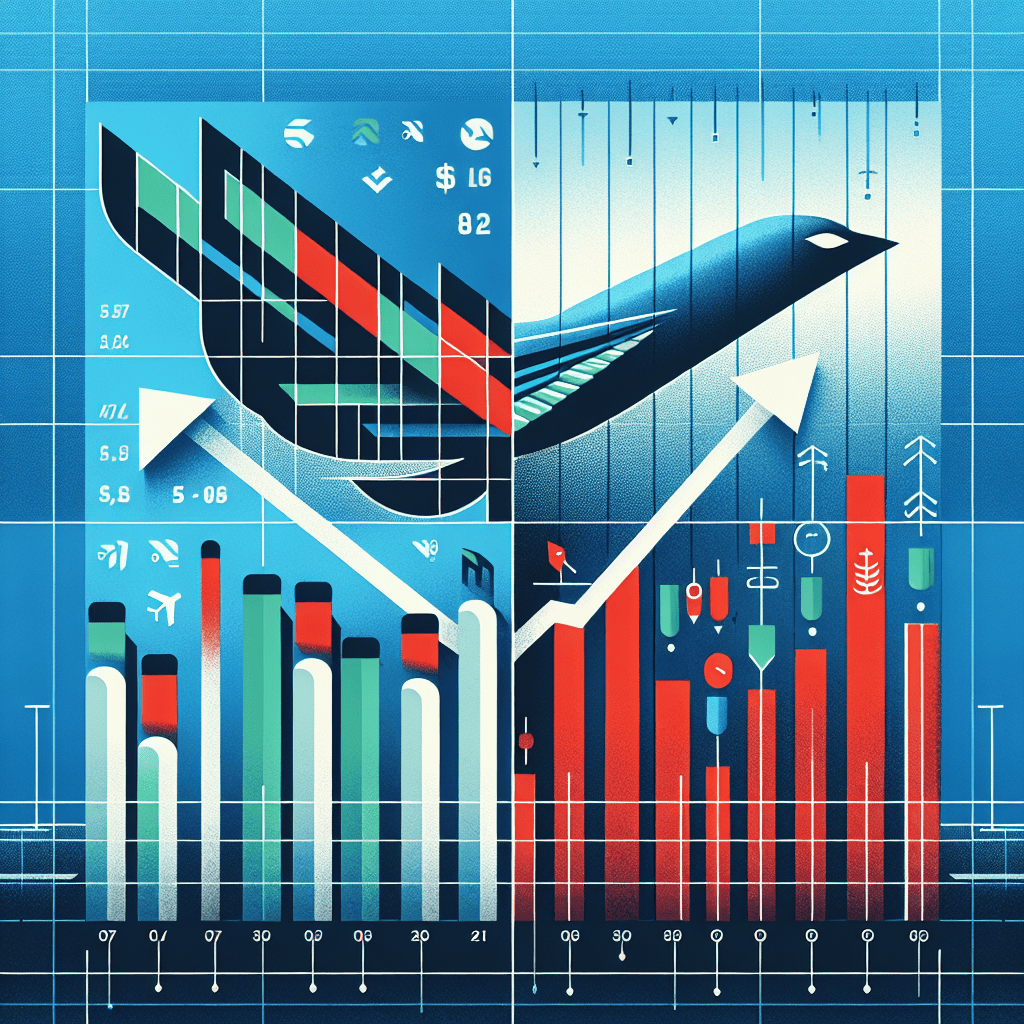“American Airlines Faces Turbulence: Mixed Earnings Lead to Stock Descent”
Introduction
American Airlines recently released its quarterly earnings report, revealing a mixed financial performance that has led to a decline in its stock value. The airline reported revenue figures that surpassed analysts’ expectations, driven by a resurgence in travel demand and strategic cost-cutting measures. However, the company’s profitability was hampered by rising fuel costs and operational challenges, resulting in earnings that fell short of market forecasts. This combination of positive revenue growth and disappointing profit margins has created uncertainty among investors, contributing to a decline in American Airlines’ stock price. As the airline navigates these financial headwinds, stakeholders are closely monitoring its strategies to enhance operational efficiency and manage external cost pressures.
Analysis Of American Airlines’ Mixed Earnings Report
American Airlines recently released its quarterly earnings report, revealing a mixed financial performance that has led to a decline in its stock value. The report highlighted both positive and negative aspects of the airline’s financial health, prompting investors and analysts to reassess their outlook on the company. As the airline industry continues to navigate a complex landscape marked by fluctuating demand and rising operational costs, American Airlines’ latest earnings report offers a snapshot of the challenges and opportunities facing the company.
To begin with, American Airlines reported an increase in revenue compared to the same period last year. This growth can be attributed to a resurgence in travel demand as more people resume flying for both business and leisure purposes. The easing of travel restrictions and the rollout of vaccination programs have played a significant role in boosting passenger numbers. Consequently, the airline has seen a rise in ticket sales, which has positively impacted its top line. However, despite this increase in revenue, the company faced several headwinds that have tempered its overall financial performance.
One of the primary challenges highlighted in the earnings report is the rising cost of fuel. As global oil prices have surged, American Airlines, like many of its peers, has experienced a significant increase in fuel expenses. This has put pressure on the company’s profit margins, as fuel costs represent a substantial portion of an airline’s operating expenses. In response, American Airlines has been exploring various strategies to mitigate these costs, including hedging fuel prices and investing in more fuel-efficient aircraft. Nevertheless, the volatility of the oil market remains a concern for the airline’s financial stability.
In addition to fuel costs, labor expenses have also contributed to the mixed earnings results. The airline industry has been grappling with a shortage of skilled workers, leading to increased wages and benefits to attract and retain employees. American Airlines has not been immune to these pressures, and the resulting rise in labor costs has further squeezed its profit margins. The company is actively working to address these challenges by implementing workforce optimization initiatives and exploring automation technologies to enhance operational efficiency.
Despite these challenges, American Airlines has made strides in improving its operational performance. The company has focused on enhancing customer experience by investing in digital technologies and upgrading its fleet. These efforts have resulted in improved on-time performance and customer satisfaction scores, which are crucial for maintaining a competitive edge in the industry. Moreover, American Airlines has been expanding its route network, particularly in international markets, to capture new growth opportunities and diversify its revenue streams.
However, the mixed earnings report has not gone unnoticed by investors, leading to a decline in American Airlines’ stock value. The market’s reaction reflects concerns about the airline’s ability to sustain profitability amid rising costs and competitive pressures. Analysts have expressed cautious optimism, noting that while the company has demonstrated resilience in navigating the current environment, it must continue to adapt to evolving market dynamics.
In conclusion, American Airlines’ latest earnings report underscores the complexities of operating in the airline industry today. While the company has achieved revenue growth and made progress in enhancing its operations, it faces significant challenges related to fuel and labor costs. As the airline continues to implement strategies to address these issues, its ability to adapt and innovate will be critical in determining its future financial performance. Investors and stakeholders will be closely monitoring American Airlines’ efforts to navigate these challenges and capitalize on emerging opportunities in the ever-changing aviation landscape.
Factors Contributing To American Airlines’ Stock Decline
American Airlines recently reported mixed earnings, which have led to a decline in its stock value. Several factors have contributed to this downturn, reflecting both internal challenges and broader industry trends. To begin with, the airline industry has been grappling with fluctuating fuel prices, which significantly impact operational costs. For American Airlines, the volatility in fuel prices has been a double-edged sword. While periods of lower prices have provided some relief, recent increases have strained the company’s financial performance, thereby affecting investor confidence.
In addition to fuel costs, labor expenses have also played a crucial role in shaping the financial landscape for American Airlines. The company has faced rising labor costs due to ongoing negotiations with unions representing pilots, flight attendants, and other staff. These negotiations have often resulted in higher wages and benefits, which, while beneficial for employees, have increased the company’s overall expenditure. Consequently, these rising costs have put pressure on profit margins, contributing to the mixed earnings report and subsequent stock decline.
Moreover, American Airlines has been navigating the complexities of post-pandemic recovery. The COVID-19 pandemic severely disrupted the airline industry, and although there has been a rebound in travel demand, the recovery has been uneven. Business travel, a significant revenue stream for airlines, has not returned to pre-pandemic levels, as companies continue to embrace remote work and virtual meetings. This shift has led to a reduction in high-margin business travel bookings, impacting American Airlines’ revenue.
Furthermore, the competitive landscape in the airline industry has intensified. Low-cost carriers have been aggressively expanding their market share, offering competitive pricing and attracting cost-conscious travelers. This increased competition has forced American Airlines to adjust its pricing strategies, often leading to reduced fares and, consequently, lower revenue per passenger. The pressure to remain competitive while maintaining profitability has been a delicate balancing act for the airline.
Another factor contributing to the stock decline is the operational challenges faced by American Airlines. The company has experienced disruptions due to weather-related events and technical issues, leading to flight cancellations and delays. These operational hiccups not only inconvenience passengers but also result in financial losses and damage to the airline’s reputation. As a result, investor sentiment has been negatively affected, further contributing to the decline in stock value.
In addition to these challenges, regulatory and environmental considerations have also played a role. The airline industry is under increasing scrutiny to reduce its carbon footprint and adopt more sustainable practices. American Airlines has been investing in more fuel-efficient aircraft and exploring alternative fuels, but these initiatives require significant capital investment. Balancing the need for sustainability with financial performance is an ongoing challenge that has implications for the company’s stock performance.
In conclusion, American Airlines’ recent mixed earnings report and subsequent stock decline can be attributed to a combination of factors. Rising fuel and labor costs, uneven post-pandemic recovery, increased competition, operational challenges, and regulatory pressures have all contributed to the current situation. As the airline navigates these complexities, it will need to implement strategic measures to address these issues and restore investor confidence. The path forward will require a careful balance of cost management, operational efficiency, and strategic investments to ensure long-term growth and stability in an ever-evolving industry landscape.
Impact Of Fuel Prices On American Airlines’ Financial Performance
American Airlines recently reported mixed earnings, which have led to a decline in its stock value. This financial performance has been significantly influenced by fluctuating fuel prices, a critical factor in the airline industry. As fuel costs represent a substantial portion of an airline’s operating expenses, any volatility in this area can have profound implications on profitability and overall financial health. In the case of American Airlines, the recent surge in fuel prices has posed challenges, impacting its earnings and investor confidence.
To understand the impact of fuel prices on American Airlines’ financial performance, it is essential to consider the broader context of the global energy market. Over the past year, geopolitical tensions and supply chain disruptions have contributed to increased volatility in oil prices. This volatility has, in turn, affected jet fuel prices, which are directly linked to crude oil prices. As a result, airlines, including American Airlines, have faced higher operating costs, squeezing profit margins and complicating financial forecasting.
Despite efforts to hedge against fuel price fluctuations, American Airlines has not been immune to these challenges. Hedging strategies, while useful, are not foolproof and can sometimes lead to additional financial burdens if market conditions shift unexpectedly. Consequently, the airline has had to navigate a complex landscape, balancing the need to manage costs with the imperative to maintain competitive pricing for consumers. This balancing act has been further complicated by the ongoing recovery from the COVID-19 pandemic, which has seen a gradual return of passenger demand but also increased operational complexities.
Moreover, the impact of rising fuel prices extends beyond immediate financial metrics. It influences strategic decisions, such as route planning and fleet management. American Airlines, like its competitors, must continuously evaluate the profitability of its routes, considering fuel costs as a critical variable. In some cases, this may lead to the suspension of less profitable routes or the reallocation of resources to more lucrative markets. Additionally, the airline must consider the long-term implications of fuel price trends on its fleet strategy, potentially accelerating investments in more fuel-efficient aircraft to mitigate future risks.
In response to these challenges, American Airlines has been exploring various strategies to enhance operational efficiency and reduce fuel consumption. These initiatives include optimizing flight paths, improving aircraft maintenance practices, and investing in new technologies. While these efforts are commendable, they require significant capital investment and time to yield substantial results. Therefore, the airline must carefully weigh these investments against other financial priorities, such as debt reduction and shareholder returns.
As American Airlines navigates this complex environment, it is crucial for stakeholders to remain informed about the factors influencing its financial performance. Investors, in particular, should consider the broader economic and geopolitical context when evaluating the airline’s prospects. While the current challenges posed by fuel prices are significant, they are not insurmountable. With prudent management and strategic foresight, American Airlines can position itself to weather these headwinds and capitalize on opportunities as market conditions stabilize.
In conclusion, the impact of fuel prices on American Airlines’ financial performance underscores the intricate interplay between external market forces and internal strategic decisions. As the airline industry continues to evolve, companies like American Airlines must remain agile and adaptive, leveraging their strengths to navigate uncertainties and drive sustainable growth.
American Airlines’ Strategic Response To Earnings Challenges

American Airlines recently reported mixed earnings, which have led to a decline in its stock value. This development has prompted the airline to reassess its strategic approach in order to address the challenges it faces. The earnings report revealed that while there were areas of growth, certain segments did not perform as expected, leading to investor concerns and a subsequent drop in stock prices. In response, American Airlines is focusing on a multi-faceted strategy to navigate these turbulent times and restore investor confidence.
To begin with, American Airlines is placing a strong emphasis on cost management. The airline industry is notoriously sensitive to fluctuations in fuel prices and labor costs, both of which have been on the rise. By implementing more efficient operational practices and renegotiating supplier contracts, American Airlines aims to mitigate these cost pressures. Additionally, the company is exploring the use of more fuel-efficient aircraft to reduce its overall fuel consumption, which is a significant expense for any airline.
Moreover, American Airlines is enhancing its customer experience to differentiate itself in a highly competitive market. Recognizing that customer satisfaction is a key driver of repeat business, the airline is investing in upgrading its fleet with more comfortable seating and state-of-the-art in-flight entertainment systems. Furthermore, American Airlines is expanding its loyalty program, offering more personalized rewards and benefits to frequent flyers. This initiative is designed to foster customer loyalty and encourage more travelers to choose American Airlines over its competitors.
In addition to these efforts, American Airlines is expanding its route network to capture new markets and increase its revenue streams. By adding new domestic and international destinations, the airline aims to attract a broader customer base and capitalize on emerging travel trends. This expansion is complemented by strategic partnerships and alliances with other airlines, which allow American Airlines to offer more seamless travel experiences and access to a wider range of destinations.
Furthermore, American Airlines is leveraging technology to improve operational efficiency and enhance the passenger experience. The airline is investing in advanced data analytics to optimize flight schedules, manage capacity, and improve on-time performance. By utilizing real-time data, American Airlines can make more informed decisions that enhance its operational effectiveness. Additionally, the airline is enhancing its digital platforms to provide customers with more convenient booking options and real-time updates on their travel itineraries.
Despite these strategic initiatives, American Airlines faces several external challenges that could impact its recovery efforts. The ongoing uncertainty in the global economy, fluctuating fuel prices, and potential regulatory changes are all factors that could influence the airline’s performance. However, American Airlines remains committed to navigating these challenges through a proactive and adaptive approach.
In conclusion, American Airlines’ mixed earnings report has prompted the company to implement a comprehensive strategy aimed at addressing its current challenges and positioning itself for future growth. By focusing on cost management, enhancing customer experience, expanding its route network, and leveraging technology, American Airlines is taking decisive steps to restore investor confidence and improve its financial performance. While external factors may pose additional challenges, the airline’s strategic response demonstrates its commitment to overcoming these obstacles and achieving long-term success. As the industry continues to evolve, American Airlines’ ability to adapt and innovate will be crucial in maintaining its competitive edge.
Comparison Of American Airlines’ Earnings With Industry Peers
American Airlines recently reported its quarterly earnings, revealing a mixed financial performance that has led to a decline in its stock value. This development has prompted investors and analysts to compare American Airlines’ earnings with those of its industry peers, providing a broader perspective on the airline’s current standing within the competitive aviation sector. As the airline industry continues to navigate post-pandemic recovery challenges, these comparisons offer valuable insights into the strategic positioning and operational efficiency of major carriers.
To begin with, American Airlines’ earnings report highlighted both strengths and weaknesses in its financial performance. The airline managed to increase its revenue, driven by a resurgence in travel demand and strategic pricing adjustments. However, rising operational costs, particularly fuel expenses, have significantly impacted its profit margins. This duality in performance is not unique to American Airlines, as many of its industry peers face similar challenges. For instance, Delta Air Lines, another major player in the industry, also reported increased revenues but struggled with cost management, particularly in fuel and labor expenses.
In contrast, Southwest Airlines has managed to maintain a relatively stable financial performance, thanks to its robust cost-control measures and a strong focus on domestic travel, which has rebounded more quickly than international routes. Southwest’s ability to keep operational costs in check has allowed it to report healthier profit margins compared to American Airlines. This comparison underscores the importance of cost management strategies in the current economic climate, where fluctuating fuel prices and labor shortages continue to pose significant challenges.
Moreover, United Airlines, another key competitor, has shown resilience by capitalizing on the recovery of international travel. United’s strategic expansion into international markets has helped offset some of the domestic challenges, providing a diversified revenue stream that has bolstered its financial performance. This approach contrasts with American Airlines’ more conservative international strategy, which has limited its ability to fully capitalize on the global travel recovery. Consequently, United’s earnings report reflects a more balanced growth trajectory, highlighting the potential benefits of a diversified market approach.
Furthermore, the competitive landscape is also shaped by the varying degrees of investment in technology and customer experience enhancements. Airlines that have prioritized digital transformation and customer service improvements, such as Delta, have reported higher customer satisfaction and loyalty, translating into better financial outcomes. American Airlines, while making strides in this area, still lags behind some of its peers in terms of technological integration and customer experience initiatives. This gap presents both a challenge and an opportunity for American Airlines to enhance its competitive edge in the future.
In conclusion, the mixed earnings report from American Airlines, coupled with the subsequent decline in its stock value, highlights the complex dynamics at play within the airline industry. By comparing American Airlines’ performance with that of its industry peers, it becomes evident that strategic decisions regarding cost management, market diversification, and customer experience are critical determinants of financial success. As the industry continues to recover and adapt to new challenges, American Airlines and its competitors must navigate these factors carefully to ensure sustainable growth and profitability. The insights gained from these comparisons not only inform investors but also guide the strategic direction of airlines as they strive to emerge stronger in a post-pandemic world.
Investor Reactions To American Airlines’ Latest Financial Results
American Airlines recently released its latest financial results, revealing a mixed earnings report that has prompted varied reactions from investors. The airline, which has been navigating the turbulent skies of the post-pandemic travel industry, reported both positive and negative aspects in its financial performance. This has led to a decline in its stock price, as investors weigh the implications of the report on the company’s future prospects.
To begin with, American Airlines reported an increase in revenue, driven by a resurgence in travel demand as more people take to the skies for both business and leisure. This uptick in revenue is a positive sign, indicating that the airline is successfully capitalizing on the recovery of the travel industry. However, despite this increase in revenue, the company faced challenges that have tempered investor enthusiasm. Rising operational costs, particularly fuel prices, have significantly impacted the airline’s profitability. The increase in fuel costs, a major expense for any airline, has eroded profit margins, leading to concerns about the company’s ability to maintain financial stability in the face of fluctuating market conditions.
Moreover, American Airlines has been grappling with labor shortages and increased wage demands, which have further strained its financial resources. The airline industry, like many others, is experiencing a tight labor market, making it difficult to recruit and retain staff. This has resulted in higher labor costs, adding another layer of complexity to the company’s financial landscape. Consequently, these challenges have raised questions among investors about the airline’s capacity to manage its expenses effectively while continuing to grow its revenue base.
In addition to these operational challenges, American Airlines is also dealing with increased competition from both traditional carriers and low-cost airlines. The competitive landscape in the airline industry is intensifying, with carriers vying for market share in a recovering travel environment. This heightened competition has put pressure on American Airlines to innovate and differentiate itself, which may require additional investment and strategic adjustments. Investors are closely monitoring how the company plans to navigate this competitive terrain and whether it can sustain its market position in the long term.
Despite these concerns, there are reasons for cautious optimism. American Airlines has been investing in modernizing its fleet and enhancing customer experience, which could pay dividends in the future. The airline’s efforts to improve operational efficiency and customer satisfaction are steps in the right direction, potentially positioning it for success as the industry continues to recover. However, the benefits of these initiatives may take time to materialize, and investors are keenly aware of the need for patience as the company implements its strategic plans.
In light of these mixed earnings results, the decline in American Airlines’ stock reflects the uncertainty and cautious sentiment among investors. While the company has demonstrated resilience in navigating the challenges of the past few years, the road ahead remains fraught with obstacles. Investors are weighing the potential for growth against the risks posed by rising costs and competitive pressures. As American Airlines continues to adapt to the evolving landscape of the airline industry, its ability to address these challenges will be crucial in shaping investor confidence and determining the trajectory of its stock performance in the coming months.
Future Outlook For American Airlines Amid Mixed Earnings
American Airlines recently reported its quarterly earnings, revealing a mixed financial performance that has led to a decline in its stock value. This development has prompted investors and analysts to closely examine the future outlook for the airline, as it navigates a complex landscape marked by both challenges and opportunities. The earnings report highlighted several key factors that have influenced the company’s financial results, including fluctuating fuel prices, labor costs, and the ongoing recovery of the travel industry post-pandemic.
To begin with, the airline’s revenue figures showed a modest increase compared to the previous quarter, driven primarily by a resurgence in domestic travel demand. This uptick in passenger numbers can be attributed to the easing of travel restrictions and a growing consumer confidence in air travel safety measures. However, despite this positive trend, American Airlines faced significant headwinds in the form of rising operational costs. Fuel prices, which have been volatile in recent months, played a substantial role in eroding profit margins. Additionally, labor costs have surged as the airline works to address staffing shortages and negotiate new contracts with its workforce.
In light of these challenges, American Airlines has been actively pursuing strategies to enhance operational efficiency and reduce costs. The company has invested in modernizing its fleet, aiming to improve fuel efficiency and reduce maintenance expenses. Furthermore, American Airlines is exploring innovative technologies to streamline operations and enhance the customer experience. These initiatives are expected to yield long-term benefits, although their impact on the current financial performance remains limited.
Transitioning to the broader industry context, the airline sector is experiencing a gradual recovery, with international travel showing signs of revival. American Airlines, with its extensive global network, stands to benefit from this trend as more countries reopen their borders and relax entry requirements. However, the pace of recovery remains uneven across different regions, influenced by varying vaccination rates and government policies. Consequently, American Airlines must remain agile in adjusting its route network and capacity to align with shifting demand patterns.
Moreover, the competitive landscape in the airline industry is intensifying, with low-cost carriers expanding their market presence and legacy airlines vying for a larger share of the lucrative business travel segment. American Airlines is responding by enhancing its loyalty program and offering premium services to attract high-value customers. These efforts are crucial for maintaining market share and driving revenue growth in a highly competitive environment.
Looking ahead, American Airlines faces a complex set of challenges and opportunities that will shape its future trajectory. The airline’s ability to navigate these dynamics will depend on its strategic decisions and adaptability to changing market conditions. While the current earnings report presents a mixed picture, there are reasons for cautious optimism. The ongoing recovery in travel demand, coupled with the company’s initiatives to improve efficiency and customer experience, provides a foundation for future growth.
In conclusion, American Airlines’ recent earnings report underscores the multifaceted nature of the challenges it faces. The decline in stock value reflects investor concerns about rising costs and competitive pressures. However, the airline’s strategic initiatives and the broader industry recovery offer potential avenues for improvement. As American Airlines continues to adapt to the evolving landscape, its future outlook will hinge on its ability to balance cost management with growth opportunities, ultimately determining its success in the post-pandemic era.
Q&A
1. **What were American Airlines’ earnings for the recent quarter?**
American Airlines reported mixed earnings, with revenue meeting expectations but profits falling short.
2. **How did American Airlines’ revenue perform?**
The airline’s revenue met analysts’ expectations, indicating stable demand.
3. **What was the reason for the decline in American Airlines’ stock?**
The stock declined due to lower-than-expected profit margins and concerns over rising operational costs.
4. **How did American Airlines’ profit compare to analyst expectations?**
The profit was below analyst expectations, contributing to the mixed earnings report.
5. **What factors contributed to the mixed earnings report?**
Factors included increased fuel costs, higher labor expenses, and competitive pricing pressures.
6. **How did the market react to American Airlines’ earnings report?**
The market reacted negatively, leading to a decline in the company’s stock price.
7. **What are American Airlines’ future outlook and guidance?**
The airline provided cautious guidance, citing ongoing challenges in cost management and competitive market conditions.
Conclusion
American Airlines reported mixed earnings, with revenue or profit figures not meeting market expectations, leading to a decline in its stock price. This suggests that investors are concerned about the company’s financial performance and future outlook, possibly due to factors such as rising operational costs, competitive pressures, or economic uncertainties affecting the airline industry. The stock decline reflects a cautious sentiment among investors, highlighting the need for American Airlines to address these challenges to regain investor confidence and stabilize its market position.





